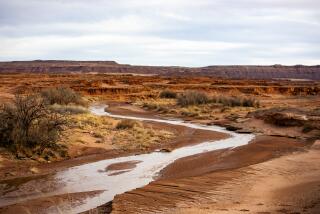Arizona’s Federal Water Project a Bitter, Costly Disappointment : The West: Cheap, plentiful supplies were supposed to wean farmers off underground water, but with a high price tag, it isn’t working as planned. California could benefit.
PHOENIX — It was shortly after World War II when Arizona’s farming, industrial and municipal interests first went to Washington to ask for help with their grandiose dream of transporting Colorado River water hundreds of miles to make the desert bloom around Phoenix and Tucson.
Nearly 50 years later, the massive, federally built engineering project they envisioned is nearing completion as construction crews put the finishing touches on the far-flung plumbing of the Central Arizona Project.
The multibillion-dollar project’s centerpiece, a 336-mile-long concrete aqueduct, pierces the desert from Lake Havasu on the California border to just beyond Tucson--a thin, blue artery carrying billions of gallons of water over mountainous terrain and dry river washes, sped by gargantuan pumps and then stored behind towering dams.
Initially funded primarily by the federal government and built by the Department of Interior’s Bureau of Reclamation, the project is being turned over in stages to the Central Arizona Water Conservation District, a state-created entity responsible for paying back the state’s share of the cost.
The completion of the CAP ought to be good news for C.L. (Bill) Scott and other Arizona farmers who were supposed to use a big chunk of the 1.5 million acre-feet of water the system can deliver each year, enough to satisfy the eventual household demands of about 7 million people.
Cheap, plentiful CAP water was supposed to wean farmers like Scott off dwindling underground water supplies. Arizona agriculture, which uses 80% of the state’s water, was supposed to provide a reliable market for CAP supplies until they were needed by residential and industrial users in the 21st Century.
But Scott, who raises 1,000 acres of cotton and seed grains on his farm 45 miles south of Phoenix, says he cannot afford to take any CAP water in 1994 unless prices are slashed. Nor, he says, can most of his neighbors in the Maricopa-Stanfield Irrigation District, all of whom are struggling with low prices for cotton--the major crop in the area--as well as repayments on bonds and loans used to finance irrigation networks for CAP water.
Under current pricing, Scott and others would pay about $61 an acre-foot (about 326,000 gallons), but the district wants to cut that to as low as $17 for farmers.
With cotton revenue down and expected CAP prices high, many growers are reverting to their former practice of pumping water from cheaper underground sources, a practice the CAP was specifically intended to reduce.
Therein lies a fundamental problem for the Central Arizona Project. It has just about everything its early proponents foresaw, except enough customers and enough income to reimburse the federal government roughly $2 billion.
Once seen as a testament to man’s ingenuity and skill at tinkering with nature, the CAP now threatens to become a monument to outdated federal water policies and flawed assumptions.
The state is scrambling to find a way to make the project work, as the first bill in a 50-year repayment schedule comes due this month. And once again, Arizona is asking for help from Washington.
The state’s proposal for financially restructuring the CAP poses a key test for Interior Secretary Bruce Babbitt and other officials who have pledged to overhaul federal water policy by reducing subsidies to agriculture, encouraging conservation and dedicating more of the resource to fish and wildlife.
The state solution, however, would dramatically increase subsidies to farmers of water-intensive crops such as cotton; shift costs to residential and industrial users; and ultimately increase the cost borne by U.S. taxpayers.
It wasn’t supposed to be this way. But then, few of the assumptions behind the CAP have held up over time.
Authorized by Congress in 1968, it was projected to cost less than $1 billion and to be built in seven years. Now, the total cost is expected to be $4.7 billion when the last yard of concrete cures in 1999, almost three decades after construction began.
Often propelled by fears of water scarcity, the CAP’s major problem is “underutilization.” With farmers declining to buy the water and whole irrigation districts defaulting on their repayment obligations, the CAP has never delivered even half of its planned capacity, and deliveries have been steadily declining for the last four years. Municipal demand for all of the water is decades away.
The cheap water envisioned by CAP advocates several decades ago is growing increasingly expensive, and residential and industrial customers may face continued tax increases to pay for the project in the face of declining agricultural demand.
Meanwhile, the federal share of the project may be $1 billion greater than anticipated, according to a recent report by the General Accounting Office.
Although mop-up construction work will continue for several years, the Interior Department last fall declared the major phase of the CAP construction project substantially complete.
That means that this month the Central Arizona Water Conservation District must begin repaying the federal government for its share of the cost. Even if the state wins an argument with Washington over how much that repayment will be, federal auditors say the state may not be able to pay off its long-term debt under the current financing structure.
So Arizona and Interior Department officials are poised early this year to begin some delicate negotiations.
Some of the key players at the department, including Babbitt and his assistant secretary for water and science, Elizabeth A. Rieke, have a long history of involvement with the CAP, he as Arizona governor and she as director of Arizona’s department of water resources.
So too does the new commissioner of the Bureau of Reclamation, Dan Beard, who is taking the lead in dealing with Arizona officials. More than a decade ago, as a young assistant to then-Interior Secretary Cecil D. Andrus, Beard clashed with Babbitt over CAP allocations to Arizona Indian tribes.
Looking over their shoulders is Rep. George Miller (D-Martinez), chairman of the Natural Resources Committee and a key player in any debate to help Arizona out of its mess.
Miller is a longtime critic of massive federal reclamation projects that heavily subsidize big agriculture. And he is from California, historically Arizona’s biggest rival for Colorado River water and a potential beneficiary if a solution to the CAP’s woes includes short-term water marketing to other states.
More to Read
Sign up for Essential California
The most important California stories and recommendations in your inbox every morning.
You may occasionally receive promotional content from the Los Angeles Times.










